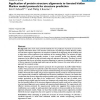107 search results - page 3 / 22 » Protein Fold Recognition using a Structural Hidden Markov Mo... |
BMCBI
2006
13 years 7 months ago
2006
Background: One of the most powerful methods for the prediction of protein structure from sequence information alone is the iterative construction of profile-type models. Because ...
BMCBI
2006
13 years 7 months ago
2006
Background: In recent years protein structure prediction methods using local structure information have shown promising improvements. The quality of new fold predictions has risen...
BMCBI
2004
13 years 7 months ago
2004
Background: The Hotdog fold was initially identified in the structure of Escherichia coli FabA and subsequently in 4-hydroxybenzoyl-CoA thioesterase from Pseudomonas sp. strain CB...
BMCBI
2010
13 years 7 months ago
2010
Background: Profile hidden Markov models (profile-HMMs) are sensitive tools for remote protein homology detection, but the main scoring algorithms, Viterbi or Forward, require con...
ICPR
2008
IEEE
14 years 1 months ago
2008
IEEE
One of the major limitations of HMM-based models is the inability to cope with topology: When applied to a visible observation (VO) sequence, HMM-based techniques have difficulty ...

